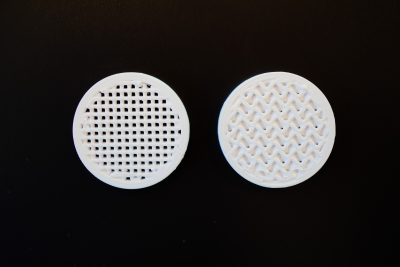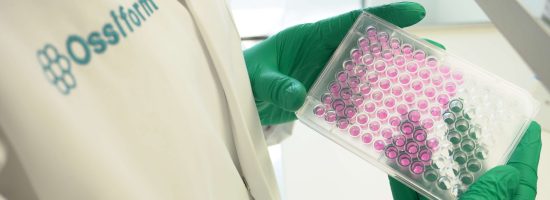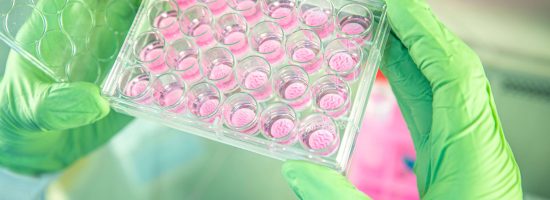Frequently Asked Questions (FAQs)
Here you can find the answers to our most frequently asked questions regarding our bioceramic bone-mimicking P3D Scaffolds.
You are also welcome to send your questions directly to us at research@ossiform.com.
General questions
3D cell culture systems are better and more predictive research models of human physiology and pathology than traditional 2D cultures because 2D culturing leads to polarized cells growing in a monolayer. The P3D Scaffolds allow cells to grow and self-organize naturally and maintain the cell-to-cell interaction and the cell-to-matrix interaction. Thereby, the three-dimensional scaffolds give more insight into the cell communication between cell types and offer an opportunity to better understand complex biology in a physiologically relevant context.
Furthermore, one disruptive driver of switching to 3D models from conventional methods is the possible reduction in the reliance on animal models to obtain more relevant data. Reducing the use of in vivo animal models, owing to the relevant and predictive data from 3D cell models, may consequently reduce the costs and time needed to develop new human therapeutics.
Read more in our blog post: How 3D culturing is revolutionizing the fields of disease modeling and regenerative medicine
The scaffolds provide physical structures that support the growth and self-organization of cells into 3D models and allow them to expand to significant numbers. Especially, the porous structure of the P3D Scaffolds maximizes cell growth sites.
The surface you choose for creating your 3D cell model is essential for obtaining reproducible results. The P3D Scaffolds allow you to use the same customized structure across tests and trials, whether for in vitro or in vivo purposes. Furthermore, the P3D Scaffolds provide an accurate replica of the calcified bone composition and stiffness of the tissue.
Yes, the P3D Scaffolds are supplied sterile by dry heat sterilization and remain sterile until opened.
Our different infill types fulfill your different research needs. Do you need to monitor cell morphology close while the cells are still in culture? – then go for our grid structure, which allows light to pass through the scaffold easily, thereby enabling you to perform regular checkups on your cells. Our data shows that cells will grow from the corners and inwards.
Is your research more focused on gaining a model system as natural as possible? Then our gyroid structure is just the right choice for you. Here you will get a randomized organization of the pores resulting in a variable pore size, making regular checkups while in culture a bit trickier, but leaving you with an in vivo cell morphology and cell behavior in an in vitro system.

How to order
We offer the following options for ordering:
- Request a non-committal quote via the formular below to get in touch with Ossiform
- Call Ossiform’s office via +45 31 75 07 21 to place your order
- Email your purchase order or quote request to sales@ossiform.com
- US and Canada distributor: Ilex Life Sciences
- DACH region distributor: Hölzel Diagnostika Handels GmbH
- International distributor: Darwin Microfluidics
Please note that we only accept payment via bank transfer. An invoice will be provided upon delivery of your order.
We will ship your order within 4-6 work days.
Upon shipment, we will provide you with courier information and an estimated date of delivery, Delivery time is typically between 2-7 work days, depending on your location.
Orders with customized products may have longer production times.
P3D Scaffolds are provided at a unit price dependent on scaffold size, or at a fixed price for a 6-, 12-, 24- or 96-well plate. The following scaffold-set options are available:
- 96x 5 mm P3D Scaffold
- 48x 5 mm P3D Scaffold
- 24x 12 mm P3D Scaffold
- 12x 20 mm P3D Scaffold
- 6x 30 mm P3D Scaffold
Get a non-committal quote by emailing us at sales@ossiform.com or fill out the form below.
Scaffold usage
Most traditional laboratory techniques are compatible with the P3D Scaffolds. If you wish to use a technique not listed below, we can provide you with six sample scaffolds for you to test out before initiating your studies.
- Inverted light microscopy (through the pores)
- Fluorescence microscopy such as for human or bacterial cells that are labelled with green fluorescent protein (GFP)
- Nucleic acid extraction for PCR and next generation sequencing (NGS)
- Staining assays such as an ALP staining assay. The dye may be detached from the 3D structures after staining for quantification using absorbance
- Enzymatic assays such as the p-nitrophenyl phosphate based assay for alkaline phosphatase activity
- Micro-computed tomography (microCT) imaging
- Scanning electronic microscopy (SEM)
- Energy-dispersive X-ray spectroscopy (EDX/EDS)
- X-ray fluorescence (XRF)
- Raman spectroscopy
- Cell recovery by trypsinization (for single cell analyses/methods like FACS and single cellsequencing)
- Confocal microscopy (LCSM)
- CellTiter-Glo 3D cell viability assay
- Live/Dead Stain
- Western Blot
Many different cells and microorganisms may be grown and studied on the 3D printed structures. These include, but are not limited to
- Stem cells including human mesenchymal stem cells, and osteoblasts. These may be used for studying bone development.
- Cancer cells including oral carcinoma, glioblastoma, and lung cancer cells. These may be used to study cancer invasion and metastasis in bones, a frequent site of cancer metastasis, and test treatments of bone tumors using therapeutics.
- Human mesenchymal stem cells and cancer cell lines can be co-cultured on the scaffolds. Thereby, you can form a realistic scenario, with cancer cells mixed in with normal cells, which subsequently can be subjected to chemotherapeutic treatment to measure and compare the effects of the chemotherapeutic responses.
- Pathogenic bacteria including staphylococcus aureus. These may be used to study osteomyelitis, surgical site infections and implant biofilms, and prevention and treatment of these conditions using pharmaceutics.
- Environmental microorganisms including bacteria and fungi. These may be used to study the interaction between environmental microorganisms and inorganic 3D structures that mimic environmental structures like soil, rocks, sediment, and building materials.
To retrieve cells from the P3D Scaffolds, an additional centrifugation step is added to ensure that any cells trapped within the scaffold are retrieved. Please see our video guides here.
Traditional methods for determining bone formation in vivo/in vitro uses staining methods which stains for calcium and collagen. If collagen is present near a calcium-rich area, it is denoted as new bone. Since the P3D Scaffolds are rich in calcium, the best solution is to fixate, stain and OCT- embed the P3D Scaffold and then cryoslicing the scaffolds. That way it is possible to look at bone formation within the infill structure, where there is no calcium from the P3D Scaffolds.
Yes. The surface structure of the scaffolds does not compromise the cells’ ability to move across the surface. Cells will disperse evenly as depicted in the image to the right.
How do I evaluate cell dispersion on the P3D Scaffold?
As the scaffold themselves are not see-through, traditional light-microscopy will not show how the cells have dispersed across the scaffold. By using a dapi stain combined with a UV-light microscope and a blue filter, you can observe how the cells are organized on the scaffold structure.
We recommend qPCR analyses for relevant marker genes to determine the degree of differentiation. As an alternative, different kit solutions can be used to determine the amount of selected enzymes/molecules in the medium, such as an ALP-assay for evaluation of osteoblast differentiation.
Some traditional stains can be used in combination with P3D Scaffolds, while others may be more difficult – this is due to two things. Firstly, the high content of calcium in the P3D Scaffolds will react to calcium stains such as Alizarin red. Secondly, the spongious structure of the scaffold will absorb the stain better. It is therefore advised to check if the dye should be diluted and to make sure that any washing steps are carried out thoroughly.
As it can be difficult to determine the surface area of the P3D Scaffolds, we recommend normalizing in respect to seeded cell number rather than surface area.
The P3D Scaffolds enable the creation of good disease models, such as bone tumors, and are useful for studying diseases like bone metastasis, osteomyelitis, and osteoporosis. For example:
- Bone destruction in osteoporosis/arthritis can be imitated by seeding osteoclasts and macrophages onto the P3D Scaffolds.
- The development of bone tumors and spreading of cancerous cells through the outer calcified bone matrix can be studied by seeding cancerous cells to the P3D Scaffolds.
- Osteomyelitis and the subsequent destruction of bone can be mimicked by adding bacteria and immune cells to the P3D Scaffolds. This enables you to study the mechanisms behind the bacteria’s destruction of the hardened calcified bone as well as how the bacteria are able to evade the immune system and antimicrobial pharmaceuticals.
Yes, you can use the P3D Scaffolds both in your laboratory research and animal trials to ensure consistency across research methods. Since the scaffolds do not contain any materials foreign to the body, they are well suited for both in vivo and in vitro tests. This secures that the conclusions derived from in vitro experiments accurately account for the events that occur in vivo.
Please visit our Publications page to see published studies.
Disclaimer: The products are “For Research Use Only (RUO)” and should not be used for clinical purposes. Ossiform makes no other warranties, expressed or implied, including the implied warranty of merchantability and the implied warranty of fitness for particular purpose.
Depending on study design and physical properties of the drug, it is definitely possible to use P3D Scaffolds for pharma-screenings. Please reach out to our team at research@ossiform.com for a solution tailored to your needs.
Scaffold handling
To ensure that the seeded cells are only growing on the scaffold, we recommend using the P3D Scaffold together with ultra low adherence plates. (such as the Ultra Low Attachment plates sold separately on the website).
Seeding cells on the P3D Scaffold is simple. Just pipet the cells onto the top and center of the P3D Scaffold. For video guidance, follow this link to our video protocols.
As our P3D Scaffolds are three-dimensional, the surface area is highly increased, and it is therefore necessary to seed more cells in order to reach confluency within a week after cell seeding.
- We recommend seeding 30,000 cells on the 5 mm scaffold.
- We recommend seeding 350,000 cells on the 12 mm scaffold.
- We recommend seeding 500,000 cells on the 20 mm scaffold.
- We recommend seeding 1,000,000 cells on the 30 mm scaffold.
Depending on the cell type and seeded amount, you can expect your cells to reach confluency within a week.
The cells can be maintained in culture for longer periods of time. The longest experiment we know of has had cells in culture for four months.
Yes, you can. Using a tweezer, you can gently transfer the P3D Scaffolds to a new well for downstream analyses or stains, without disturbing the remaining cell wells in the plate.
Just keep them in their box at room temperature. Please keep them out of humid areas such as a refrigerator if you plan to keep them there for longer periods of time.
Yes. We have had P3D Scaffolds in liquid nitrogen without any issues. It is therefore possible to keep fixated scaffolds on ice/in the freezer without breaking the scaffolds.
Yes. The P3D Scaffolds are produced by heating them to above 1000 degrees Celsius. They are highly temperature resistant and can safely be heated if your studies require so.
No. As the scaffolds are bioceramic, they may break, crack or crumble if they are cut into without support. If our standard sizes and shapes do not fit with your specific research aim, please let us know and we will guide you through the process of getting your customized P3D Scaffolds.
Physical and Chemical Properties
You can choose between:
- Two different designs (grid or gyroid)
- Four different standard sizes: Ø5, Ø12, Ø20 or Ø30 mm
Further design modifications are available upon request for a specially designed P3D Scaffold tailored to your in vitro or in vivo study. Our proprietary technique allows us to print almost any size and pore size you may wish. Please reach out to our team at research@ossiform.com and they will guide you through the design process. Please note that custom scaffolds are subject to a 300€ customization fee.
P3D Scaffolds are polymer free and consist solely of β-tricalcium phosphate (β-TCP). The scaffolds are 3D printed from Ossiform’s novel nonpolymeric bioink which consists of β-TCP and fatty acid. By default, the fatty acid is removed through sintering.
P3D Scaffolds are available in regular β-TCP or ultra clean (medical grade) β-TCP.
Did you not find what you were looking for?
Do not hesitate to contact us at research@ossiform.com or call +45 3175 0721.


